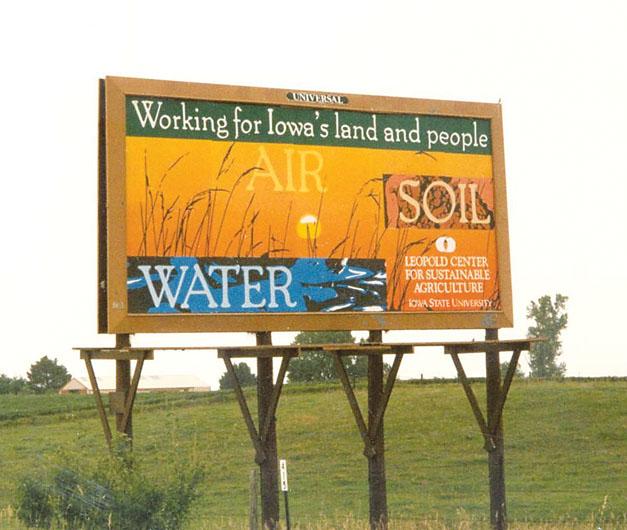George Washington Carver Internship Program gives student rich cultural experience
The Leopold Center was created to help protect Iowa’s water, air and soil. It is depicted in this billboard that marked the Center’s 10th anniversary in 1997.
July 20, 2011
Irene Bitsoi has been working on a project that deals with an important part of Native American culture: corn.
“The project is maize juvenile and adult crisis,” Bitsoi said. “I am trying to determine the juvenile and adult traits of maize plant cells.”
Bitsoi is an intern in the Plant Genome Research Outreach for Native Americans program, a subproject of the George Washington Carver (GWC) Summer Internship Program.
As part of the GWC program, students are given the opportunity to work with the College of Agriculture and Life Sciences faculty for a summer. And in this program Bitsoi is learning more about corn, which is valued in her native culture.
“The George Washington Carver Internship Program is one of the best recruitment programs conducted through the College of Agriculture and Life Sciences,” said Mary de Baca, director of diversity programs in the College of Agriculture and Life Sciences. “About 18 to 20 percent of the interns actually go on to enroll at ISU. It is a multicultural program that attracts applicants from all across the U.S.”
The Plant Genome Research Outreach for Native Americans program was started in 2006 by the Agricultural Research Service. Instrumental in beginning the program were U.S. Department of Agriculture scientists Carolyn Lawrence and Candice Gardner, who also collaborate with the College of Agriculture and Life Sciences.
“They wanted something to do with native outreach,” de Baca said. “They wanted to know what they could learn from the native perspective of corn, and we got a National Science Foundation grant that provided for the funding to bring in some Native American students.”
Bitsoi is now a sophomore studying biology at the University of New Mexico. Bitsoi started the internship program in June 2010, making this her second year in it. Bitsoi is a part of the Navajo tribe. She found out about the program through her uncle, Lee Bitsoi, who works at Harvard University. He became acquainted with Carolyn Lawrence through his and her shared work to provide science outreach opportunities to native students.
Bitsoi is sponsored by the Monsanto Corporation. Monsanto is one of five sources of funding for the program. The other institutions that provide funding are the USDA’s Agricultural Research Service, the National Science Foundation, the ISU Department of Entomology and the ISU Department of Genetics Development and Cell Biology.
Another project Bitsoi is working on under the guidance of Ethalinda (Ethy) Cannon in Lawrence’s group is the 2011 Native American outreach website.
“I’m learning HTML coding, which is something new to me,” Bitsoi said.
This year, American Indian tribal elders from the Native American Outreach Program came to Iowa State to meet with the student interns and project personnel.
“They get a taste of Western research, and also to share some of their cultural background and interests with us,” de Baca said. “We have done that every year with the Native American Outreach Program.”
The American Indian tribal elders and the student interns can discuss the importance of their research and impart their insight to the student. Many of the student interns are from the Navajo tribe.
“Corn is an important species to the Navajo,” Lawrence said. “It is not only food, but it also has cultural significance.”
They also discuss the importance of science from the cultural perspective.
“In native cultures, a lot of the cultural beliefs are developed through observation,” Lawrence said. “With science, that is also the case. Science is a good way to tie in with their culture.”
When Bitsoi became part of the program in June 2010, she joined to gain experience and see what it had to offer. After the program concluded, she knew she wanted to go back.
“When I came here, I knew nothing of corn,” Bitsoi said. “I learned a lot about corn. There is more to corn. Corn is a good natural resource. And it expands my knowledge because it is giving me the courage to go more into it and make a career out of it.”
Despite being far away from New Mexico, Bitsoi has enjoyed working with program faculty.
“My mentors are very helpful, and are always there,” Bitsoi said. “I’m so far away from home, and they make the environment easier for me.”
Though she is only a sophomore, Bitsoi sees this internship as great experience to apply to a future career.
“I’m pretty sure that I’ll learn more to give me an idea of what I want to do when I do graduate,” Bitsoi said. “I think … I’m off to a good start. I’m pretty motivated to do something more with the summer experience, and make something out of it and give back to the program.”

















